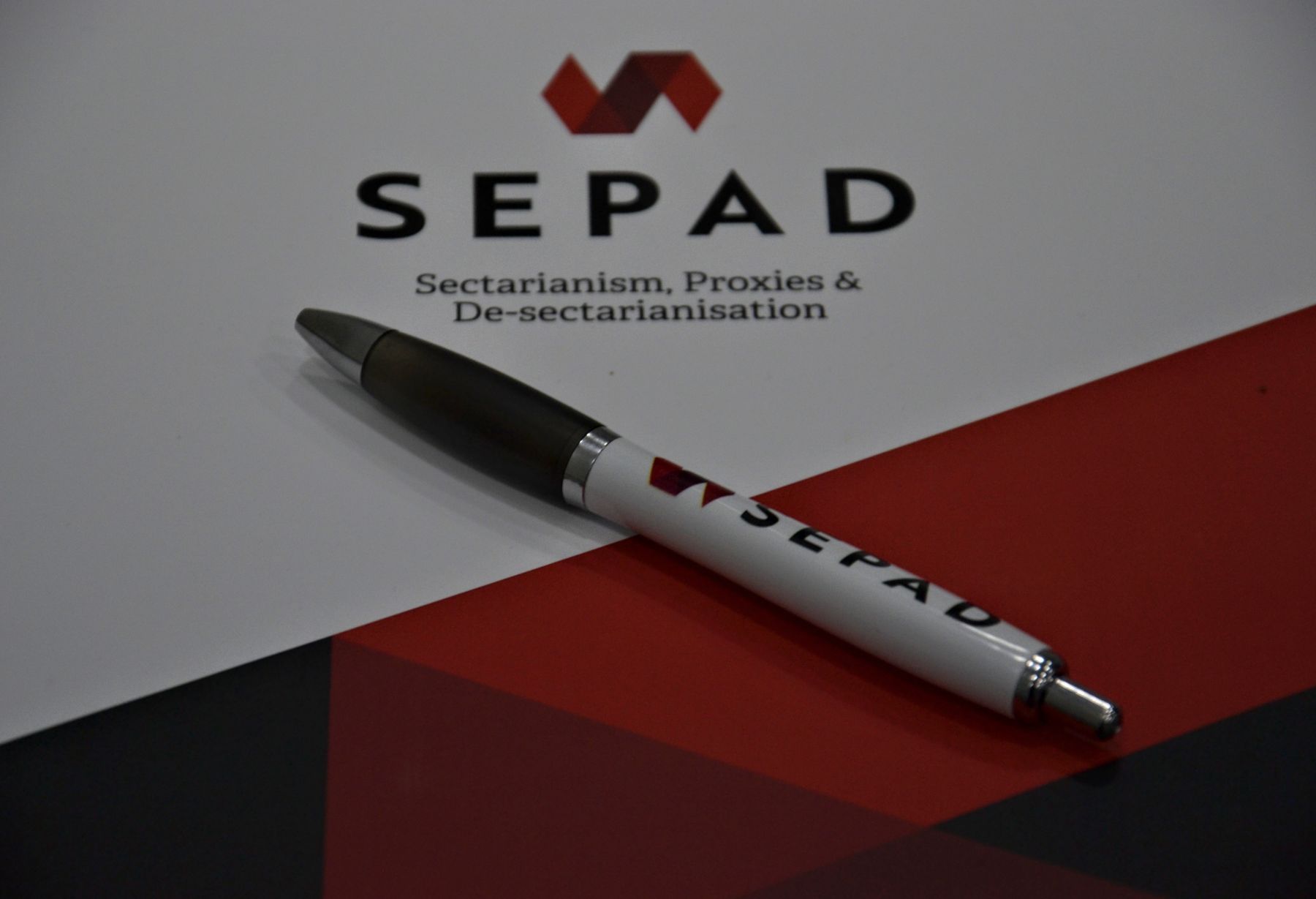Tishreen Feminist Artivism: Iraqi woman beyond sectarian identity
12th Oct 2022 by Hadeel Abdelhameed

One of the singularities of women’s contribution in the Tishreen movement was its spontaneous and organic sentiments that took women’s activism beyond the NGO, and SCO’s mainstream. The multiscalar involvement of women in Tishreen showed a unique modus operandi that embodied women’s genuine understanding(s) of, and response(s) to, the identity crisis among the Iraqi young generation. Undoubtedly, women’s logistic support backboned the mundane life inside the protest spaces, sustaining the continuum of the protest, and marking a realistic manifestation of coexistence cultivated by a collective sense of belonging. Women protesters reappropriated the protest squares as imagined unified societies vis-à-vis the divisive nature of cities outside protest spaces. Although this form of women’s activism is considered as an enforcement to the traditional role gender, it was undeniably momentous as it signified women’s reclaiming of the public space. Women who occupied the protest squares, regardless of their activities, restructured the politics of the public spaces. It is important to refer here that Iraqi cities, centres and peripheries, have been structured around a profound gender-spatial inequality producing masculinised, militarised, and recently sectarianised cultures of public spaces. These sectarian-politico-military divisive factors have been enforcing a segregated identity of the public space, and, thus, producing fragmented identities of its dwellers. Tishreen women’s activism disrupted this discursive discourse of gender, and sectarian splintered identity of the space and of the protesters alike. An unprecedented form of Iraqi women’s activism emerged in Tishreen responding to the politics of division- be that spatial, gender, or sectarian. Driven by the organic and leaderless ethos of Tishreen that welcomed protesters from diverse sectarian, religious, gender, class, and ethnic backgrounds, a group of Tishreen women were involved in producing artivism; a portmanteau practice that fuses artistic productions and social and political activism. An unparalleled explosion of feminist street art and graffiti furnished the walls, concrete barriers, and tunnels in the protest space, (re)claiming the public space by women artivists, and sending running sectarian, and gender counter- narratives. Tishreen women artivism spoke to the originality of Tishreen itself, its horizontal form, tactic and narrative of mobilisation, producing a genuine art-based activism that resisted previously given identities marred by sectarian fragmentation, and gender segregation.
Despite the plethora in the scholarship produced about women’s artistic production during social movement in the South Globe in general and MENA in particular, this literature leaves the sectarian-gendered identity and artivism under-researched. While the relation between women’s visibility in public spaces during political mobilisation was early investigated by gender theorists, the focus on feminist artivism was recently introduced, though. Some feminist activistsanalysed women artivism in relation to the security and urban violence, MENA Feminist scholars studied Egyptian women’s artistic campaign against sexual harassment during the Egyptian revolution. Other specialists in politics of aesthetics educated on the role of street arts in protest movements in revolutionising women’s activism in Egypt. This report builds on this repertoire by introducing Iraqi women’s artivism that produced anti-sectarian street art during the Tishreen protest movement. It is also based on a workshop run in late July 2022 in collaboration with the SEPAD project under the title: “How Do Protest Spaces Contribute to the De-sectarianisation of Women's Identities?”, and a recently published report that was based on semi-structured interviews with Iraqi women Tishreen protesters from Baghdad, Basra, and Thi Qar.
Driven by the democratic sentiments of the protest squares, Iraqi women artivists produced hundreds of murals, graffiti, and other street drawings that materialised revolutionaries’ imaginative undivided and equal societies, and visually enunciated their artistic potentials. Most of these street arts portrayed women artivists’ understanding of, and the need for, a national identity that exists and interacts according to a supranational and de-sectarian rhetoric. Tishreen feminist artivism exhibited Iraqi women’s awareness of their divided identities, hence the street arts they produced signified them as Iraqi citizens who are in struggle against the politics of division. One of the artivists, R. H. a newly graduated student from the school of Dentistry/ Baghdad University, besides being a practising dentist, R. is also an artist. Her contribution to the Tishreen movement was not limited to being a paramedic, working with other doctors, and volunteers to attend to the injured, but also, she drew several graffiti’s on the walls of Al-Tahrir tunnel. “I was thinking why there were not many graffities that document Iraqi women’s activism?” She decided to occupy this spot on the wall, and the first thing came to her mind, as she said, was to express her sense of belonging to the collective Iraqi identity, the identity that passes the barriers of fragmentation whether religious or sectarian.

This famous graffiti of R. shows a young woman wearing two necklaces. The first is of a crescent, the symbol of Islam, and the other one is of a cross, the symbol of Christianity. She affirmed that this graffiti visualised what she thought to be all Iraqi women protesters felt and were eager to share in public. R. asserted that women artivists were aware that Tishreen provided the space, symbolic and physical, to show that the Iraqi gendered identity cannot be limited to religious, or sectarian identities: “my identity is simply Iraqi... just Iraqi” as R. said.
This form of feminist activism interrupts not only socio- political (dis)orders, but also urban artistic and creative discourses, confirming how far can art-based contribution to anti-government protests provide local gendered knowledge about divided societies. Graffities such as of R. reconfigured the politics of the public space of Al-Tahrir square. These street arts gendered the identity of the public space that have been for long masculinised, militarised and sectarianised. Tishreen was that tempo-spatial platform when and where women artivists shared genuine voices, contesting hegemonic rhetoric that politicised national identity. In this sense, women's artivism is an intersectional model of democracy that sits at the interconnectedness of gender equity, freedom of expression, citizenship and nationhood.
Several feminist scholars highlighted the lack of a clear egalitarian gender agenda in Tishreen, emphasising the dangerous discourse of Iraqi women’s activism during recent social movement that usually silhouetted behind male activism. It is important to highlight that Tishreen feminist Artivism was a form of women’s activism that transcended gender barriers, and labels to sits on the intersectionality of freedom of expression- be that political or artistry from one hand, and the imaginary identity those women sought for on the other hand.
Most of the graffiti produced by women artivists whether in Baghdad, Najaf, and Basra, reverberated women’s resistance to the state’s discursive process of identity cleavage. The public space becomes a cultural platform exhibiting ethos of transformation against divisions, and subdivisions normalised by authorities. Y. R. is another young women artivists who found in drawing graffiti a method to express her views about de-sextarianising the place. Y’s graffiti showed two lions; a male and a female, wearing the Baghdadi red yashmagh, sharing the same frowns, and features, standing side by side under the written words: Baghdad is the castle of lions[1]. Y asserted that the reason behind drawing this graffiti was that: “I wanted to do something different, to say something different, the graffiti I left in Al- Tahrir subway materialised my loyalty to Iraq, the Iraq I imagine living in”

Conclusion:
Due to the scarcity of democratic spaces, and the fragility of the security status quo in post-conflict societies that are marred with ethno-sectarian divisions, women’s artvisism becomes meaningful, and powerful as it is stimulated by the organic climate (moment) of democracy. Bringing colours, choosing the theme, identifying the wall, and before all deciding to draw a graffiti as a form of activism, all manifested women’s will to leave a memorial trace in the public place. Images and portrays depicted by women artivists declared how Iraq cities such as Baghdad, Basra or Thi Qar should be imagined and perceived by their women inhabitants, creating new sensibilities of women’s imaginaries of their urban places that are usually depicted for violence, gender-based or systematic, division, and intolerance. Those graffiti emphasised the importance of women’s revolutionary practices in re-appropriating protest places challenging the process of sectariansing the public space and suspending the divisive nature of these cities. One of the young women artivists said: “I wanted my graffiti to stay in Al-Tahrir, to be evidence of my identity as an Iraqi citizen, not only as a woman” This view of citizenhood that is based on the art of coexistence, and ethics of companionship highlights that Tishreen is more than a social movement, it is a dynamic that once taking place, it willd stay and continue to be transformative
[1] This is a renowned song produced in 1958 in Egypt and sung by the famous female singer Um Kalthoum, it was for long the intro music for the Iraqi national news channel.
